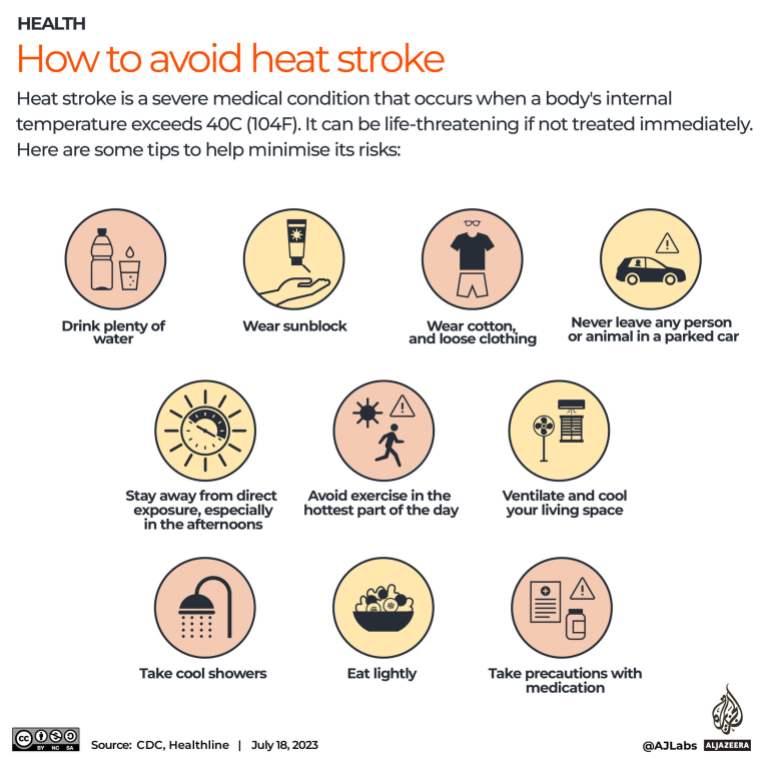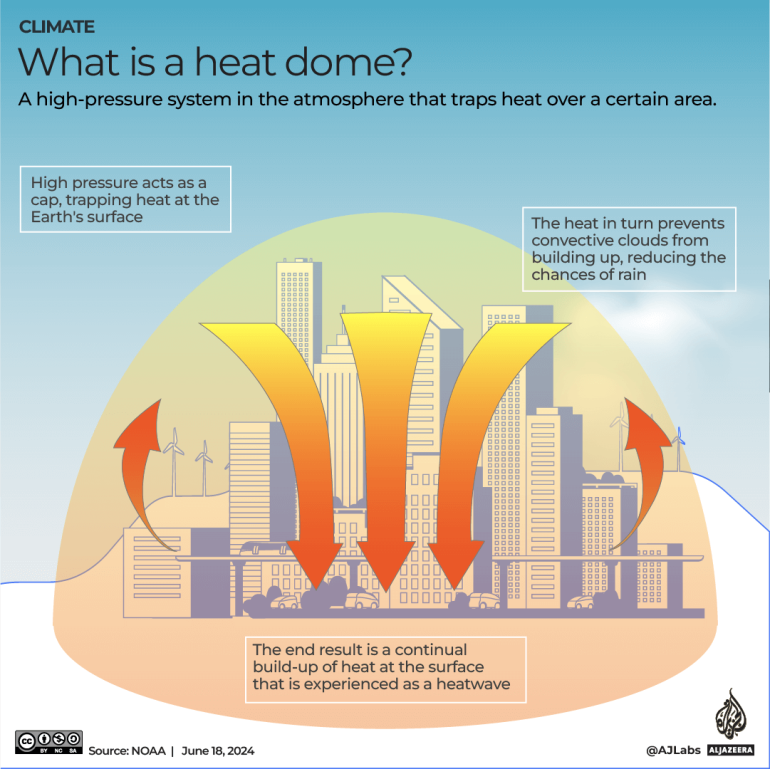EXPLAINER
Last year, the US saw the most number of heatwaves since 1936 and it is now bracing for an unusually hot June.
More than 75 million people across the United States, especially in the Midwest and East Coast, are living amid extreme heat alerts even before the first official day of summer this Thursday.
Much of the US Midwest has been witnessing scorching heat with temperatures expected to surpass 37.8 degrees Celsius (100 degrees Fahrenheit), with meteorologists saying the extreme heat is caused by excessive humidity and domes of hot air in the atmosphere. Weather scientists describe the phenomenon as heat domes.
So what is a “heat dome” and how is it connected to a heatwave?
What is a heat dome?
A heat dome is a weather phenomenon where a high-pressure area is formed in the atmosphere, which traps hot air beneath like a lid traps air in a pot.
The pressure pushes air down into a hotter, dome-shaped mass and prevents the milder weather systems from moving through.
This heat dome creates prolonged periods of excessively high temperatures, adding to a heatwave.

Are heat domes driving heatwaves in the US?
Heat domes this week will fuel temperatures 20-30F (11-16.5C) hotter than normal for June, according to the National Weather Service.
Parameters for what counts as a “heatwave” are relative to the region. Typically, an area is said to be going through a heatwave when it experiences at least two or more days of weather that exceeds usual temperatures in that period.
A heatwave in the northeast US, for example, is when the temperature reaches or exceeds 32.2C (90F) for three consecutive days.
Heat domes are more common in southern and western parts of the country, which are already prone to hot weather.
Heat domes have been forming over the US for decades now, but the phrase seems to have caught on over the last few years. The American Meteorological Society added “heat dome” to its glossary of terms in March 2022.
Moreover, the frequency of heatwaves in the country has increased.
In big US cities, heatwave instances have increased from two per year in the 1960s to six per year since the 2010s, according to a report published by the country’s Environmental Protection Agency last year.
Several cities have also observed more intense and longer heatwaves since the 1960s.

And beyond the US?
Heat domes have sweltered countries beyond the US too.
In Mexico last month, at least 22 people were killed and monkeys were spotted dropping dead from trees due to suspected dehydration as the country faced a heatwave fuelled by heat domes.
In August 2023, a heat dome over France led to its hottest late summer days since 1947. It lasted about a week while nationwide average temperatures climbed to 27.8C (82F). In southern parts of the country, however, the mercury pushed past 40C (104F).
What to do during a heatwave?
Health authorities around the world urge people to take certain precautions during a heatwave. These include staying hydrated, avoiding strenuous outdoor activities and staying indoors during peak hours of the day.
Additional advice can include placing a damp cloth on one’s head, neck and face, which may create a cooling effect. Avoiding high-protein foods can also reduce dehydration and keep the body’s internal temperature low as digesting protein requires more water and generates metabolic heat.
People may also be asked to keep their home’s energy consumption in check. During last year’s heatwave in the US, residents of the Texas metropolis were asked to conserve energy from 2pm to 10pm Saturday through Monday to mitigate high demand.

How long does a heat dome last?
It can last for several days to a few weeks. In some cases, a heat dome can carry on for two weeks or more. The National Weather Service’s heat advisories are in place till 8pm EDT (12:00 GMT) on Thursday or Friday, depending on the city.
After that, temperatures will gradually ease but remain above normal the following week.
The exact duration of the heat dome depends on the strength and persistence of the high-pressure system that creates and sustains it.
The National Weather Service has also forecast that some of the areas most at risk of extreme heat include Chicago, as well as parts of midwestern states Iowa, Wisconsin and Indiana. Residents can expect “rare and/or long-duration extreme heat with little to no overnight relief”.
Cities such as New York and Pittsburgh are not far behind, where people without effective cooling or adequate can especially be affected by the heat which may peak on Thursday and Friday.
Read More: World News | Entertainment News | Celeb News
Aljazera








